人教版(2019)选择性必修第三册Unit 2 Healthy Lifestyle Reading and Thinking 课件&说课课件(共35张PPT)
文档属性
| 名称 | 人教版(2019)选择性必修第三册Unit 2 Healthy Lifestyle Reading and Thinking 课件&说课课件(共35张PPT) | 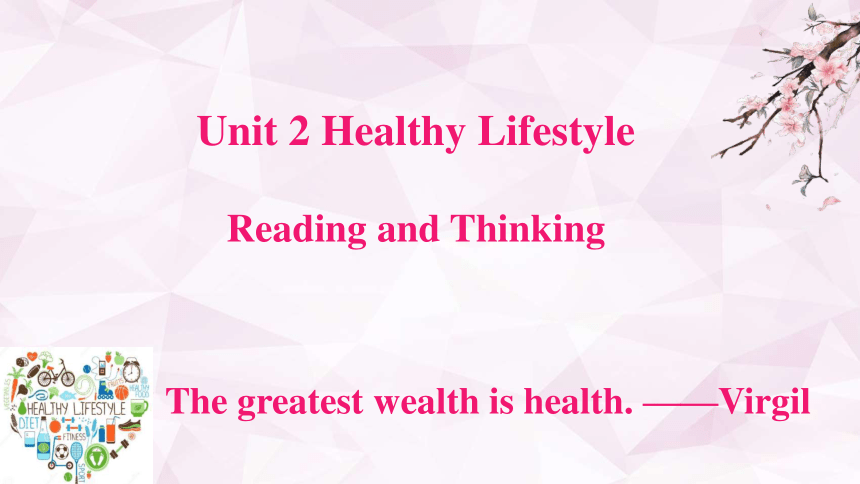 | |
| 格式 | pptx | ||
| 文件大小 | 3.3MB | ||
| 资源类型 | 教案 | ||
| 版本资源 | 人教版(2019) | ||
| 科目 | 英语 | ||
| 更新时间 | 2024-03-15 20:39:09 | ||
图片预览

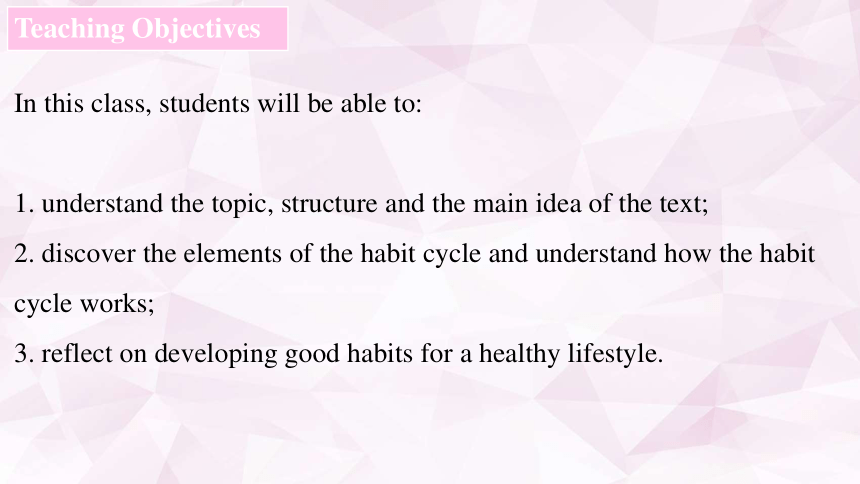

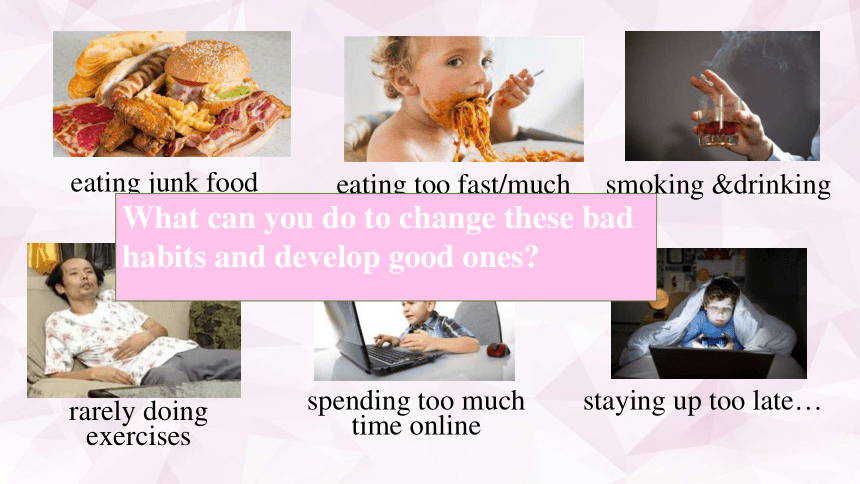

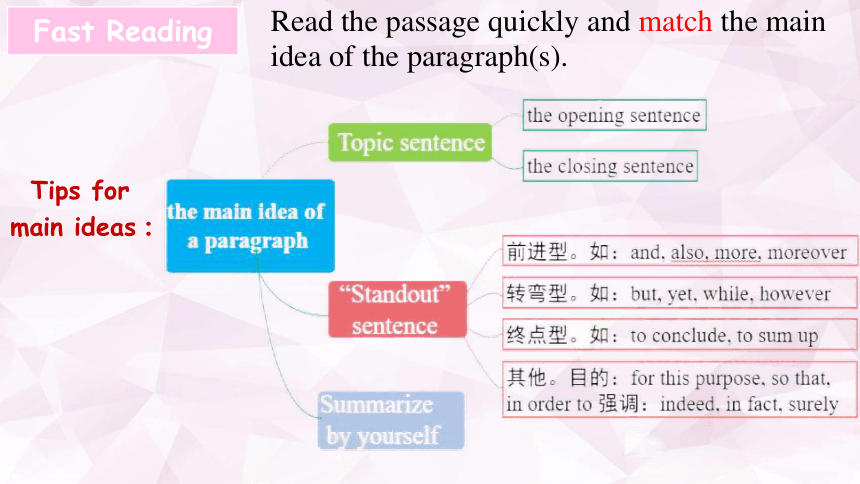
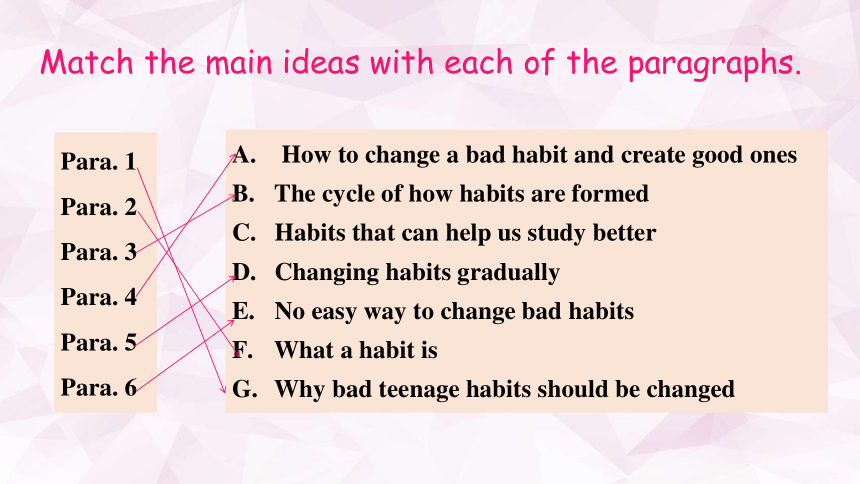
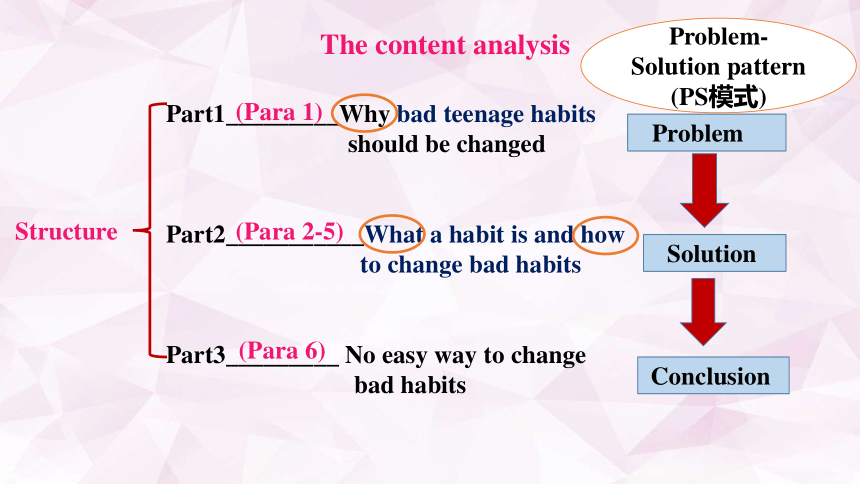
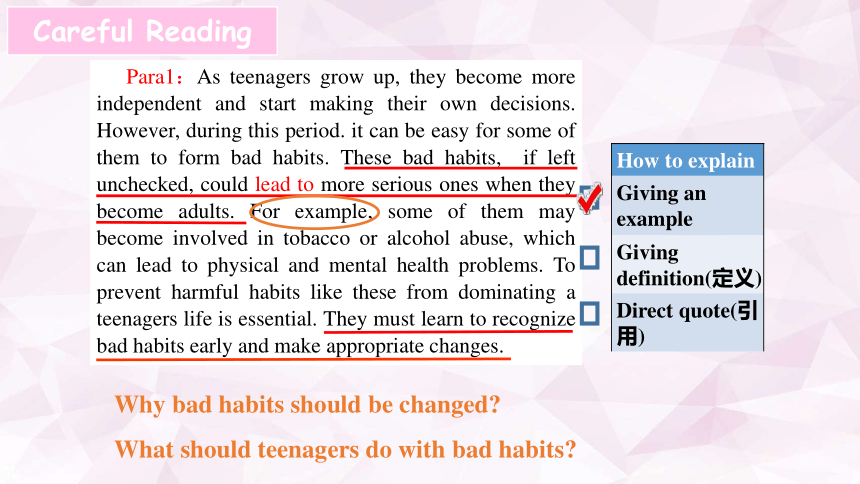
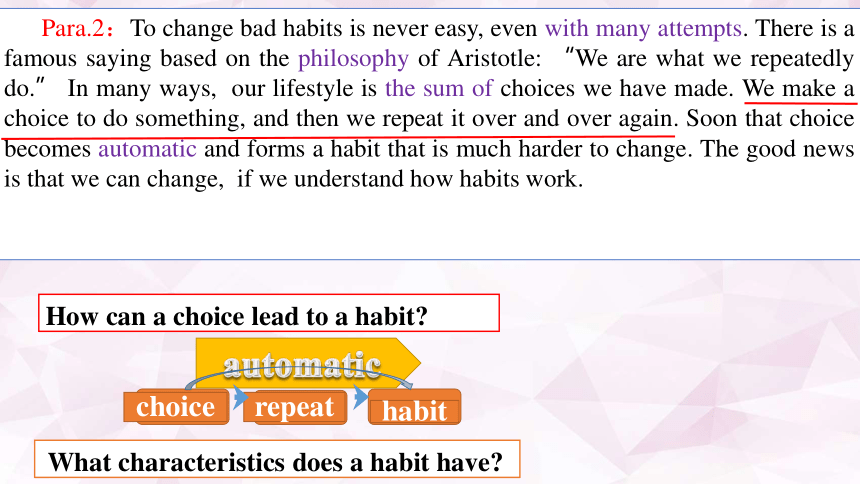
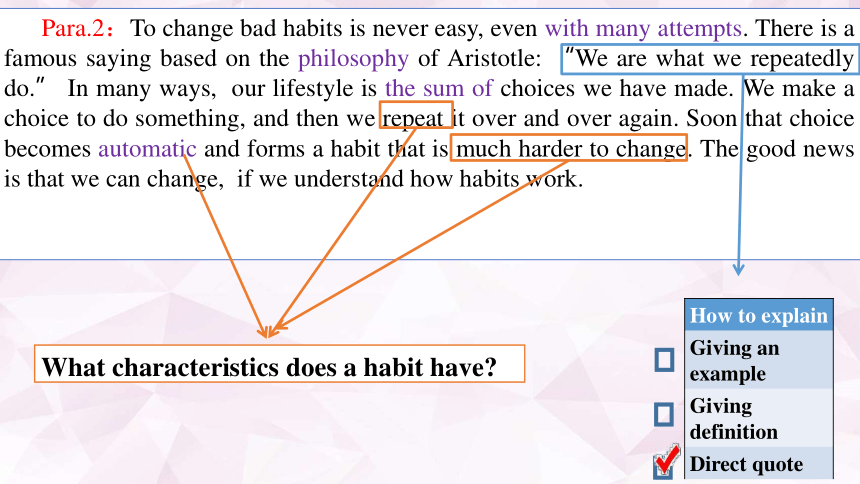

文档简介
(共35张PPT)
The greatest wealth is health. ——Virgil
Unit 2 Healthy Lifestyle
Reading and Thinking
In this class, students will be able to:
1. understand the topic, structure and the main idea of the text;
2. discover the elements of the habit cycle and understand how the habit cycle works;
3. reflect on developing good habits for a healthy lifestyle.
Teaching Objectives
What are they doing Do you think they are all leading a healthy lifestyle
Lead-in
eating junk food
rarely doing exercises
staying up too late…
eating too fast/much
spending too much time online
smoking &drinking
What can you do to change these bad habits and develop good ones
Habits for a Healthy Lifestyle
What are the key words in the title
What may the genre (体裁)of the text be
Narration(记叙文)
Exposition(说明文)
Argumentation(议论文)
Habits; Healthy
Skim the title and answer the following questions.
Skim and predict
Read the passage quickly and match the main idea of the paragraph(s).
Fast Reading
Tips for
main ideas:
Match the main ideas with each of the paragraphs.
A. How to change a bad habit and create good ones
The cycle of how habits are formed
Habits that can help us study better
Changing habits gradually
No easy way to change bad habits
What a habit is
Why bad teenage habits should be changed
Para. 1
Para. 2
Para. 3
Para. 4
Para. 5
Para. 6
The content analysis
Part1_________Why bad teenage habits
should be changed
Part2___________What a habit is and how
to change bad habits
Part3_________ No easy way to change
bad habits
Problem-Solution pattern
(PS模式)
Conclusion
Solution
Problem
(Para 1)
(Para 2-5)
(Para 6)
Structure
Para1:As teenagers grow up, they become more independent and start making their own decisions. However, during this period. it can be easy for some of them to form bad habits. These bad habits, if left unchecked, could lead to more serious ones when they become adults. For example, some of them may become involved in tobacco or alcohol abuse, which can lead to physical and mental health problems. To prevent harmful habits like these from dominating a teenagers life is essential. They must learn to recognize bad habits early and make appropriate changes.
Why bad habits should be changed
What should teenagers do with bad habits
How to explain
Giving an example
Giving definition(定义)
Direct quote(引用)
Careful Reading
Para.2:To change bad habits is never easy, even with many attempts. There is a famous saying based on the philosophy of Aristotle: “We are what we repeatedly do.” In many ways, our lifestyle is the sum of choices we have made. We make a choice to do something, and then we repeat it over and over again. Soon that choice becomes automatic and forms a habit that is much harder to change. The good news is that we can change, if we understand how habits work.
How can a choice lead to a habit
What characteristics does a habit have
choice
repeat
habit
automatic
Para.2:To change bad habits is never easy, even with many attempts. There is a famous saying based on the philosophy of Aristotle: “We are what we repeatedly do.” In many ways, our lifestyle is the sum of choices we have made. We make a choice to do something, and then we repeat it over and over again. Soon that choice becomes automatic and forms a habit that is much harder to change. The good news is that we can change, if we understand how habits work.
What characteristics does a habit have
How to explain
Giving an example
Giving definition
Direct quote
Para3:According to modern psychology, we must first learn about the “habit cycle”, which works like this:
Firstly there is a “cue”, an action, event, or situation that acts as a signal to do something.
Secondly there is a “routine”, the regular action you take in response to the cue.
Thirdly, there is the “reward”, the good thing or feeling we get from the routine.
For example, when we feel unhappy (cue). We eat lots of unhealthy snacks (routine) which make, us happy (reward). The reward makes us much more likely to continue the cycle, and the bad habit of relying on unhealthy snacks is formed.
How to explain
Giving an example
Giving definition
Direct quote
What are the three stages of the “habit cycle”
To promote a change, we must first _________ our bad habit cycle and try to _______ them by replacing a ________ routine with something more _________. We can also use the habit cycle to _______ good habits.
examine
adapt
negative
positive
create
Read Para4 and fill in the blanks with the words in the para.
habit cycle
Routine
overeating
habit cycle
Routine
listen to music
cue
sad
cue
sad
Reward
happy
Reward
happy
Para.5 Many of us try to change bad habits quickly, and if we are not successful straight away, we often become pessimistic and give up. In fact, the most successful way to change is not suddenly, but over a period of time. As the Chinese philosopher Lao Zi wrote, “A journey of a thousand miles begins with a single step.” One step seems small, but it is essential. To reach the goal of change, a person must show some discipline and repeatedly take many small steps. After all, it is not easy to break bad habits.
What else are needed if we want to change a bad habit
A.time
B.discipline
C.repeated small steps
D.all of above
√
How to explain
Giving an example
Giving definition
Direct quote
Para.6:For young people, there is plenty of time to change bad habits. However, there is no "magic pill" or delete button that will help you; you have to think about your bad habits and decide on some changes. You have the power to build a happy and healthy life full of good habits!
They refer to easy ways.
√
metaphor
What do “magic pill” and “delete button” refer to
What kind of attitude does the author hold to changing bad habits
A.Negative. B.Sad. C.Doubtful. D.Positive.
What methods are used to explain the topic in this exposition
There is a famous saying based on the philosopher Aristotle, “We are what we repeatedly do.”
For example, we could try to replace a negative routine with something more positive.
According to modern psychology, we must first learn about the “habit cycle”, which works like this:
example
quotation
definition
However, there is no “magic pill” or delete button that will help you;
metaphor
chart
Language features
Post-reading
1.Think of one bad habit of yours and write down the cue, routine, and reward. Then come up with an idea of how to break the bad habit.
2.Do you know any alternative ways to better habits Which way do you think is the most effective
Creative thinking
Example
feel bored
play online games
A: You almost fell asleep in the English class. Did you stay up late last night
B: Yes, I played computer games until midnight. I just can’t help playing games when I feel bored. I know it’s a bad habit. To change the bad habit……
B: Do you know any alternative ways to better habits
A: ……
How
sleepy in the class
Summary
Small choices become actions, actions become habits and habits become our way of life.
Conclusion
Solution
Problem
Ss read the two letters on the Internet asking for help on how to overcome the bad habits. Then choose one to write a reply and offer concrete suggestions.
Homework
Teaching Plan
3
4
5
Text Analysis
Teaching Procedures
Teaching Objectives
Teaching Reflection
Students Analysis
2
1
文本分析
教学目标
教学过程
教学反思
学情分析
文章标题Habits for a Healthy Lifestyle点明了主题意义,即为健康生活方式培养良好的习惯。开头部分提出青少年坏的生活习惯为什么要改变的问题,然后分析习惯如何形成及习惯循环原理,接着提出问题解决的方法,最后进行总结,整篇文章脉络清晰。全文可分为四个部分:第一部分为提出问题(第一段),第二部分为分析问题(第二段和第三段),第三部分为解决问题(第四段和第五段),第四部分为总结(第六段)。
文本分析 - What
文本分析
教学目标
教学过程
教学反思
学情分析
本文旨在促使学生在理解文本主题意义的基础上,关注个人身心健康和良好习惯的培养,从而树立积极的生活态度和健康的生活方式,同时提升识别问题、分析问题和解决问题的意识和能力。
文本分析 - Why
文本分析
教学目标
教学过程
教学反思
学情分析
文本是一篇问题解决型的说明性文本,从问题的提出到解决可以概括为why、what、how三个层面。行文中作者使用第一人称,拉近与读者的距离。文中习惯循环图示的运用和举例说明以及改变坏习惯创造好习惯方法的举例说明更清晰准确地展示和表达了本篇说明文中想要表达的具体意义。其次,两次引用中外名人语录也是此文章的一大特点,使说明文的内容更充实具体、更具说服力。最后作者通过直接点明写作对象和第二人称的使用勉励青少年做出改变努力养成好习惯、过健康幸福的生活,与题目相呼应,呈现文本的主题意义。
文本分析 - How
文本分析
教学目标
教学过程
教学反思
学情分析
作为高二年级学生,他们在英语的阅读方面已经具备了一定的阅读能力,对英语学习有兴趣和想学好英语的较强烈欲望,且对说明文的基本文本特征,如写作目的、作者态度等有一定的了解,对文章话题“ 人与自我——健康的生活方式”具备一定的常识,能有自己的见解。但部分学生可能没法快速提取问题解决型的说明性文本的基本框架,概括段落大意技巧仍停留在找首尾句等较直接、显性的方式,难以把握句子间逻辑,从而提炼段落主旨大意。
文本分析
教学目标
教学过程
教学反思
学情分析
Teaching objectives:
1.Understand the topic, structure and the main idea of the text.
2. Discover the elements of the habit cycle and understand how the habit cycle works.
3. Reflect on developing good habits for a healthy lifestyle.
Teaching key points:
Guide students to master the main content of the passage and the structural features of the problem-solving explanation text.
Teaching difficult points:
Enable students to understand how the habit cycle works, and use it to change bad habits and develop good habits.
Pre-reading reflection and discussion to help students develop reading expectations
文本分析
教学目标
教学过程
教学反思
学情分析
Step1: Lead-in
Present some pictures and ask students the following questions:
1. What are they doing
2. Do you think they are all leading a healthy lifestyle
3. What can you do to change these bad habits and develop good ones
Introduce the topic and develop reading expectations.
Pre-reading reflection and discussion to help students develop reading expectations
文本分析
教学目标
教学过程
教学反思
学情分析
Skim and Predict: Skim the title and answer questions.
Fast Reading: Match the main ideas with each of the paragraphs and analyze the structure of the text.
Careful Reading: Read for details of each paragraph.
1) make predictions about the text based on the title;
2) get the main idea of each paragraph;
3) practice the skill of reading for details and know how the habit cycle works.
Step2: While- reading
Pre-reading reflection and discussion to help students develop reading expectations
文本分析
教学目标
教学过程
教学反思
学情分析
Step2: While- reading
文本分析
教学目标
教学过程
教学反思
学情分析
1)Write down the cue, routine, and reward of your bad habit and think about the way to break the bad habit and other alternative ways to better habits.
2) Make a dialogue and then invite some groups to the front and present their dialogues.
To develop students’ understanding on the “habit cycle” and enable them to make use of it to develop good health habits
Step3: Post- reading
文本分析
教学目标
教学过程
教学反思
学情分析
Step3: Post- reading
文本分析
教学目标
教学过程
教学反思
学情分析
Step 4: Summary
1) Invite some students to make a summary as to what they learnt.
2) End the class with a quote about habit.
Further consolidate what have been learned in this class and call on students to develop good habits based on the habit cycle.
文本分析
教学目标
教学过程
教学反思
学情分析
Step 5: Homework
To provide further chances for them to apply what has been learned about the “habit cycle” to solving real-life problems.
Thanks
The greatest wealth is health. ——Virgil
Unit 2 Healthy Lifestyle
Reading and Thinking
In this class, students will be able to:
1. understand the topic, structure and the main idea of the text;
2. discover the elements of the habit cycle and understand how the habit cycle works;
3. reflect on developing good habits for a healthy lifestyle.
Teaching Objectives
What are they doing Do you think they are all leading a healthy lifestyle
Lead-in
eating junk food
rarely doing exercises
staying up too late…
eating too fast/much
spending too much time online
smoking &drinking
What can you do to change these bad habits and develop good ones
Habits for a Healthy Lifestyle
What are the key words in the title
What may the genre (体裁)of the text be
Narration(记叙文)
Exposition(说明文)
Argumentation(议论文)
Habits; Healthy
Skim the title and answer the following questions.
Skim and predict
Read the passage quickly and match the main idea of the paragraph(s).
Fast Reading
Tips for
main ideas:
Match the main ideas with each of the paragraphs.
A. How to change a bad habit and create good ones
The cycle of how habits are formed
Habits that can help us study better
Changing habits gradually
No easy way to change bad habits
What a habit is
Why bad teenage habits should be changed
Para. 1
Para. 2
Para. 3
Para. 4
Para. 5
Para. 6
The content analysis
Part1_________Why bad teenage habits
should be changed
Part2___________What a habit is and how
to change bad habits
Part3_________ No easy way to change
bad habits
Problem-Solution pattern
(PS模式)
Conclusion
Solution
Problem
(Para 1)
(Para 2-5)
(Para 6)
Structure
Para1:As teenagers grow up, they become more independent and start making their own decisions. However, during this period. it can be easy for some of them to form bad habits. These bad habits, if left unchecked, could lead to more serious ones when they become adults. For example, some of them may become involved in tobacco or alcohol abuse, which can lead to physical and mental health problems. To prevent harmful habits like these from dominating a teenagers life is essential. They must learn to recognize bad habits early and make appropriate changes.
Why bad habits should be changed
What should teenagers do with bad habits
How to explain
Giving an example
Giving definition(定义)
Direct quote(引用)
Careful Reading
Para.2:To change bad habits is never easy, even with many attempts. There is a famous saying based on the philosophy of Aristotle: “We are what we repeatedly do.” In many ways, our lifestyle is the sum of choices we have made. We make a choice to do something, and then we repeat it over and over again. Soon that choice becomes automatic and forms a habit that is much harder to change. The good news is that we can change, if we understand how habits work.
How can a choice lead to a habit
What characteristics does a habit have
choice
repeat
habit
automatic
Para.2:To change bad habits is never easy, even with many attempts. There is a famous saying based on the philosophy of Aristotle: “We are what we repeatedly do.” In many ways, our lifestyle is the sum of choices we have made. We make a choice to do something, and then we repeat it over and over again. Soon that choice becomes automatic and forms a habit that is much harder to change. The good news is that we can change, if we understand how habits work.
What characteristics does a habit have
How to explain
Giving an example
Giving definition
Direct quote
Para3:According to modern psychology, we must first learn about the “habit cycle”, which works like this:
Firstly there is a “cue”, an action, event, or situation that acts as a signal to do something.
Secondly there is a “routine”, the regular action you take in response to the cue.
Thirdly, there is the “reward”, the good thing or feeling we get from the routine.
For example, when we feel unhappy (cue). We eat lots of unhealthy snacks (routine) which make, us happy (reward). The reward makes us much more likely to continue the cycle, and the bad habit of relying on unhealthy snacks is formed.
How to explain
Giving an example
Giving definition
Direct quote
What are the three stages of the “habit cycle”
To promote a change, we must first _________ our bad habit cycle and try to _______ them by replacing a ________ routine with something more _________. We can also use the habit cycle to _______ good habits.
examine
adapt
negative
positive
create
Read Para4 and fill in the blanks with the words in the para.
habit cycle
Routine
overeating
habit cycle
Routine
listen to music
cue
sad
cue
sad
Reward
happy
Reward
happy
Para.5 Many of us try to change bad habits quickly, and if we are not successful straight away, we often become pessimistic and give up. In fact, the most successful way to change is not suddenly, but over a period of time. As the Chinese philosopher Lao Zi wrote, “A journey of a thousand miles begins with a single step.” One step seems small, but it is essential. To reach the goal of change, a person must show some discipline and repeatedly take many small steps. After all, it is not easy to break bad habits.
What else are needed if we want to change a bad habit
A.time
B.discipline
C.repeated small steps
D.all of above
√
How to explain
Giving an example
Giving definition
Direct quote
Para.6:For young people, there is plenty of time to change bad habits. However, there is no "magic pill" or delete button that will help you; you have to think about your bad habits and decide on some changes. You have the power to build a happy and healthy life full of good habits!
They refer to easy ways.
√
metaphor
What do “magic pill” and “delete button” refer to
What kind of attitude does the author hold to changing bad habits
A.Negative. B.Sad. C.Doubtful. D.Positive.
What methods are used to explain the topic in this exposition
There is a famous saying based on the philosopher Aristotle, “We are what we repeatedly do.”
For example, we could try to replace a negative routine with something more positive.
According to modern psychology, we must first learn about the “habit cycle”, which works like this:
example
quotation
definition
However, there is no “magic pill” or delete button that will help you;
metaphor
chart
Language features
Post-reading
1.Think of one bad habit of yours and write down the cue, routine, and reward. Then come up with an idea of how to break the bad habit.
2.Do you know any alternative ways to better habits Which way do you think is the most effective
Creative thinking
Example
feel bored
play online games
A: You almost fell asleep in the English class. Did you stay up late last night
B: Yes, I played computer games until midnight. I just can’t help playing games when I feel bored. I know it’s a bad habit. To change the bad habit……
B: Do you know any alternative ways to better habits
A: ……
How
sleepy in the class
Summary
Small choices become actions, actions become habits and habits become our way of life.
Conclusion
Solution
Problem
Ss read the two letters on the Internet asking for help on how to overcome the bad habits. Then choose one to write a reply and offer concrete suggestions.
Homework
Teaching Plan
3
4
5
Text Analysis
Teaching Procedures
Teaching Objectives
Teaching Reflection
Students Analysis
2
1
文本分析
教学目标
教学过程
教学反思
学情分析
文章标题Habits for a Healthy Lifestyle点明了主题意义,即为健康生活方式培养良好的习惯。开头部分提出青少年坏的生活习惯为什么要改变的问题,然后分析习惯如何形成及习惯循环原理,接着提出问题解决的方法,最后进行总结,整篇文章脉络清晰。全文可分为四个部分:第一部分为提出问题(第一段),第二部分为分析问题(第二段和第三段),第三部分为解决问题(第四段和第五段),第四部分为总结(第六段)。
文本分析 - What
文本分析
教学目标
教学过程
教学反思
学情分析
本文旨在促使学生在理解文本主题意义的基础上,关注个人身心健康和良好习惯的培养,从而树立积极的生活态度和健康的生活方式,同时提升识别问题、分析问题和解决问题的意识和能力。
文本分析 - Why
文本分析
教学目标
教学过程
教学反思
学情分析
文本是一篇问题解决型的说明性文本,从问题的提出到解决可以概括为why、what、how三个层面。行文中作者使用第一人称,拉近与读者的距离。文中习惯循环图示的运用和举例说明以及改变坏习惯创造好习惯方法的举例说明更清晰准确地展示和表达了本篇说明文中想要表达的具体意义。其次,两次引用中外名人语录也是此文章的一大特点,使说明文的内容更充实具体、更具说服力。最后作者通过直接点明写作对象和第二人称的使用勉励青少年做出改变努力养成好习惯、过健康幸福的生活,与题目相呼应,呈现文本的主题意义。
文本分析 - How
文本分析
教学目标
教学过程
教学反思
学情分析
作为高二年级学生,他们在英语的阅读方面已经具备了一定的阅读能力,对英语学习有兴趣和想学好英语的较强烈欲望,且对说明文的基本文本特征,如写作目的、作者态度等有一定的了解,对文章话题“ 人与自我——健康的生活方式”具备一定的常识,能有自己的见解。但部分学生可能没法快速提取问题解决型的说明性文本的基本框架,概括段落大意技巧仍停留在找首尾句等较直接、显性的方式,难以把握句子间逻辑,从而提炼段落主旨大意。
文本分析
教学目标
教学过程
教学反思
学情分析
Teaching objectives:
1.Understand the topic, structure and the main idea of the text.
2. Discover the elements of the habit cycle and understand how the habit cycle works.
3. Reflect on developing good habits for a healthy lifestyle.
Teaching key points:
Guide students to master the main content of the passage and the structural features of the problem-solving explanation text.
Teaching difficult points:
Enable students to understand how the habit cycle works, and use it to change bad habits and develop good habits.
Pre-reading reflection and discussion to help students develop reading expectations
文本分析
教学目标
教学过程
教学反思
学情分析
Step1: Lead-in
Present some pictures and ask students the following questions:
1. What are they doing
2. Do you think they are all leading a healthy lifestyle
3. What can you do to change these bad habits and develop good ones
Introduce the topic and develop reading expectations.
Pre-reading reflection and discussion to help students develop reading expectations
文本分析
教学目标
教学过程
教学反思
学情分析
Skim and Predict: Skim the title and answer questions.
Fast Reading: Match the main ideas with each of the paragraphs and analyze the structure of the text.
Careful Reading: Read for details of each paragraph.
1) make predictions about the text based on the title;
2) get the main idea of each paragraph;
3) practice the skill of reading for details and know how the habit cycle works.
Step2: While- reading
Pre-reading reflection and discussion to help students develop reading expectations
文本分析
教学目标
教学过程
教学反思
学情分析
Step2: While- reading
文本分析
教学目标
教学过程
教学反思
学情分析
1)Write down the cue, routine, and reward of your bad habit and think about the way to break the bad habit and other alternative ways to better habits.
2) Make a dialogue and then invite some groups to the front and present their dialogues.
To develop students’ understanding on the “habit cycle” and enable them to make use of it to develop good health habits
Step3: Post- reading
文本分析
教学目标
教学过程
教学反思
学情分析
Step3: Post- reading
文本分析
教学目标
教学过程
教学反思
学情分析
Step 4: Summary
1) Invite some students to make a summary as to what they learnt.
2) End the class with a quote about habit.
Further consolidate what have been learned in this class and call on students to develop good habits based on the habit cycle.
文本分析
教学目标
教学过程
教学反思
学情分析
Step 5: Homework
To provide further chances for them to apply what has been learned about the “habit cycle” to solving real-life problems.
Thanks
